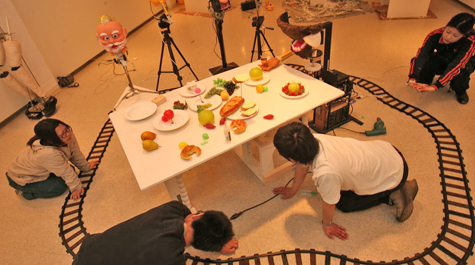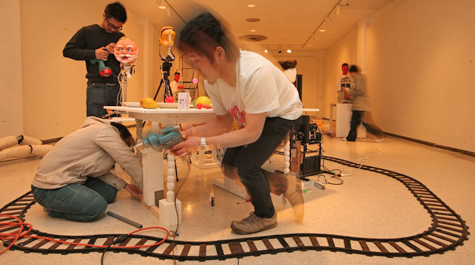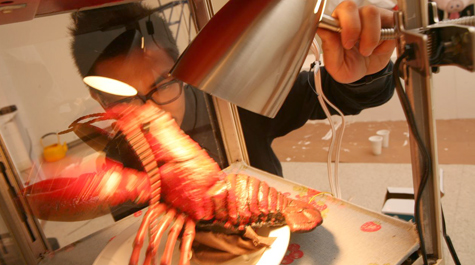Future Shock: A startling experience
The exhibit is one of the many elements comprising Mercury: A Hazard Without Borders, a sustained Global Inquiry Group (sGIG) initiated by the Wendy and Emery Reves Center for International Studies. International and interdisciplinary in focus, GIGs bring faculty and students from a number of departments together around a common intellectual thread.
Future Shock is the work of Kenichi Miyazawa and Jun Sugiyama, students from Musashino Art University in Japan, who came to the U.S. with three assistants. All five worked feverishly to assemble the complex installation, which Elizabeth Mead calls a poetic commentary on the incorporation of fast-food culture into the Japanese lifestyle. The installation is the reciprocal portion of an arrangement between Japanese sculptor Yoji Matsumura, and Mead, assistant professor of art at William & Mary.
As a participant in the sGIG, Mead taught a sculpture course called Sculpture in the Global Environment: Heavy Metal and the Delta Blues. Mead had sent mercury-themed sculpture by her students to be exhibited at Musashino Art University. The same group of works was displayed in conjunction with a biomath class poster session in Millington.
“We looked at two case studies in terms of environmental disasters; one was mercury contamination and the other was Hurricane Katrina,” Mead said. “My students made sculptural works in response to these incidents.”
Future Shock, and its installation by the Musashino Art University students, was the Japanese response.
“In Japan, they have a great deal of sensitivity about mercury, relating to the Minimata spill in the early 30s, so it’s had a radical impact on Japanese history,” Mead said. “We all know it because of the Eugene Smith photographs, including Tomoko Uemura in Her Bath.”
The widely circulated Eugene Smith photos depict residents of Minimata, a bayside Japanese city, whose nervous systems and bodies were crippled by severe mercury poisoning from industrial pollution of the bay and its seafood. (Mead will be curating a Smith exhibit at the Muscarelle Museum next April, a part of the 2010 International Mercury Expo, being planned as the capstone event of the mercury GIG.)
“When Yuji and I first started talking, he kept asking me ‘Why mercury?, Why now?’ because for Japan, the ’30s was when the mercury happened, while we’re just now dealing with the effects of it, from coal-burning plants and so on,” Mead said. She pointed to an artist’s statement from Future Shock that indicates that in the wake of the Minimata disaster, Japanese seafood consumption has been in decline, being replaced by animal proteins, especially American-style fast food. Future Shock, she said, is a commentary on the effects of mercury in the longer, less direct, term.
“It’s a huge installation, completely mechanized,” Mead said. “There are figures on a track that go around and around and they are talking about the way we get caught up in cycles. The idea is that we are repeating ourselves and we need to break these cycles.”
An opening reception for Future Shock will be held from 4:30 to 6 p.m. on April 6. A gallery talk will be held at 5 p.m. on April 7. Andrews Gallery is open from 10 a.m. to 5 p.m. Mondays through Fridays.
Funding for the event comes from the Reves Center, the College of Arts & Sciences and the Asian Studies Initiative, funded by the Freeman Foundation.


















